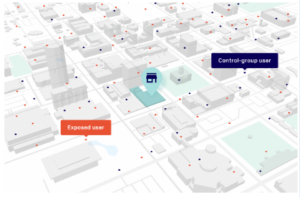Tired of playing the guessing game?
What if you could predict exactly where your DOOH ads will make the biggest impact, before you even launch your campaign? Imagine knowing not just who your audience is, but where they’ll be and when they’re most likely to see your message. With Locala’s Panel Optimizer, this vision is now a reality. Our new feature delivers real-time, data-driven scoring, empowering you to place your ads with precision and maximize the reach of every campaign.

From Challenges to Innovation: The Story of the Panel Optimizer
In a world where consumers are constantly on the move, knowing exactly when and where to place your ads is crucial. But without precise targeting, too many DOOH ads end up in locations where a significant portion of the audience may not be relevant or interested in the message. It’s like casting a super wide net, and then just hoping to catch the right fish, often coming up empty.
The Panel Optimizer addresses this challenge by scoring each DOOH panel based on your audience’s Opportunity to See (OTS). This means you can pinpoint high-impact panels and times, helping you make more informed decisions about your media spend. No more guesswork, just clear, actionable insights that optimize your reach and boost campaign performance.
How the Panel Optimizer Works:
The Panel Optimizer simplifies the complexities of DOOH buying with three key capabilities:
- Who: Identify the areas with the highest concentration of your ideal audience using advanced sociodemographic data.
- Where: Pinpoint the exact panels and inventory types that align with where your audience is most likely to be.
- When: Leverage real-time passerby data to serve your ads at optimal times, maximizing their visibility and impact.
Step 1: Select Your Audience
With Locala’s AI-powered Planning tool, we’ll define your audience using sociodemographic data and pinpoint key regions to ensure your ads reach the right people.

Step 2: Define Target Area & Inventory
Further refine your planning by selecting target areas and inventory. Locala’s platform identifies panels in real-time, ensuring your ads reach relevant locations and minimize waste.

Step 3: Activate DOOH Scoring
With DOOH Scoring, the Panel Optimizer uses real-time data to score panels based on Likelihood to See (LTS), helping you focus spend on the most impactful placements for efficient, effective campaigns.

Step 4: Refine & Optimize
Refine your audience with behavioral segments to make campaigns more dynamic. The platform continuously updates DOOH Scores in real-time, ensuring maximum impact.

Step 5: Measure & Adjust
Monitor real-time performance metrics and make data-driven adjustments during your campaign, ensuring it delivers optimal results from start to finish.
With these insights, brands can activate DOOH campaigns that truly resonate with their target audience, driving results without wasting budget.
A New Standard in DOOH Scoring:
At Locala, we believe that the metrics that drive success in digital advertising—like viewability and attention—should also apply to DOOH. That’s why our DOOH Scoring isn’t just about identifying available inventory; it’s about using real-time data to understand your audience’s behavior and ensuring your message hits at the most effective moments. With the Panel Optimizer, your DOOH campaigns become more than just ads—they become tailored experiences that connect with consumers effectively in the real world.
The Edge You Need in the DOOH World
With the Panel Optimizer, brands will target only the panels that align with their audience, eliminating wasted spend and increasing efficiency. This approach broadens reach and amplifies impact, delivering ads at the right moments to capture attention. Backed by real-time insights, marketers make confident decisions, ensuring their strategies stay responsive, data-driven, and optimized for success.
Start Benefiting from DOOH Panel Scoring Today
We’re proud to be at the forefront of DOOH innovation, helping brands navigate the evolving landscape with tools that make their campaigns more effective and impactful. With the Panel Optimizer, we’re offering a new way to reach audiences in the moments that matter most. Let’s make your next campaign the best one yet.
Whether you’re looking to refine your targeting, increase campaign impact, or make smarter media buys, the Panel Optimizer unlocks the full potential of DOOH Scoring. Ready to see it in action? Contact us today to learn more about what this means for your brand.





 Our front-end developers recently attended
Our front-end developers recently attended 


